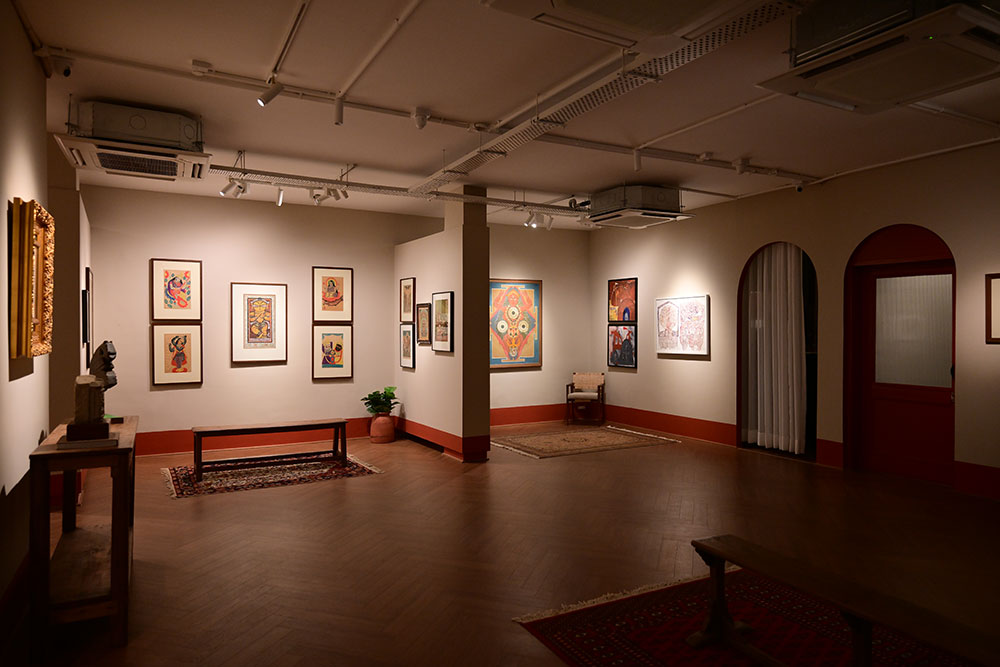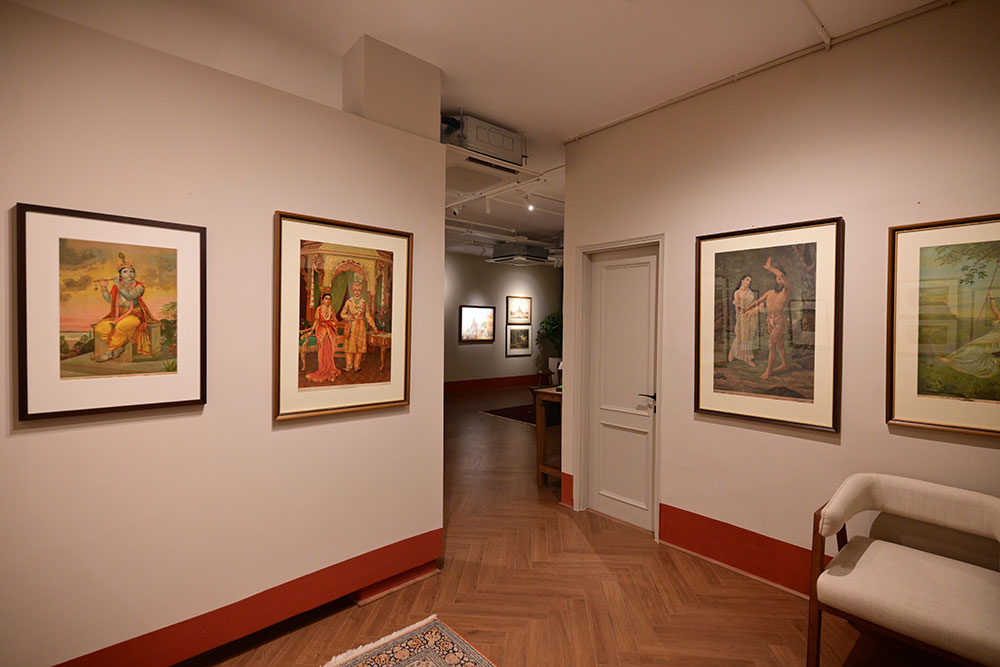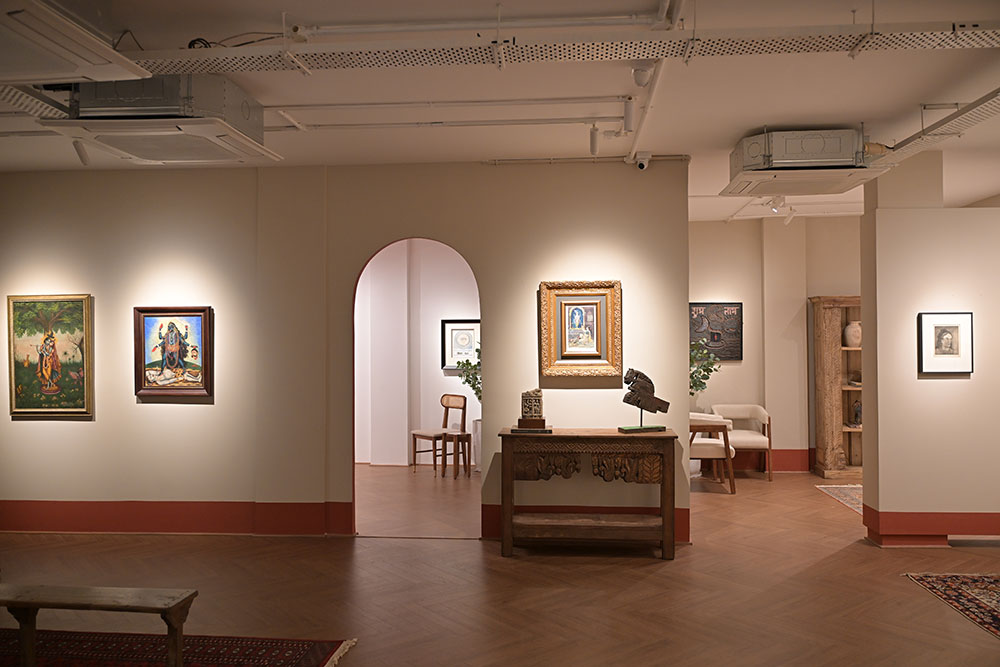Inside Kalaakar: How A Private Art Salon Is Turning Art Viewing Into An Experience
Tucked away in quiet lanes of Delhi’s Defence Colony, Kalakaar revives art patronage with private viewings. It breaks away from transactional ambience of white-cube galleries and crowded art fairs to offer an intimate, deeper, and richer bond with art
Last year, at an exhibition celebrating India’s modernist masters, this writer found herself lost in the raw intensity of an F.N. Souza painting when a young visitor, barely in his twenties, broke the silence and earnestly asked: “Did you understand the artwork?” His eyes still searched for meaning amid Souza’s semi-abstract strokes. What began as a casual exchange soon turned into a conversation unravelling the painting’s threads tied to themes of identity, spirituality, and post-colonial angst.
“Thanks,” he said adding, “It just enriched the art viewing experience.” That serendipitous encounter revealed a deeper truth — how the white-cube galleries of today, pristine yet impersonal, often leave visitors either daunted or detached. The missing piece? What’s missing is connection, and intimacy with artwork.
Cut to now. In an art market dominated by commercial purposes and artworks displayed at sterile white-cube galleries, the newly opened private art salon Kalaakar is rewriting the rules of art viewing: making it private, richer and familiar. Conceived by Indian art collectors Saira and Shivin Khanna, the salon’s tour at Delhi was a much-needed detour from the marketplace-driven art shows and overcrowded art fairs.

Art as experience
Situated in the quaint lanes of Defence Colony, Kalaakar is located in a private home’s second floor. As we entered, a spacious central hallway adorned with Persian carpets was rolled on the floor, stacking sold out works. The hallway was connected to different rooms without doors to allow free flow of movement for art enthusiasts, collectors, and connoisseurs. Corners were adorned with earthen pots bringing a touch of rusticity. Handwoven chairs and benches encouraged slow-looking and richer conversations over art.
“The concept of a private art salon like Kalaakar is that we wanted to keep art in a more lived in space,” says Saira who with a background in logistics, and AI brings structural precision and curatorial clarity to the space. “An art salon is different from a gallery as we do not have white cube walls. We want people to come and enjoy art in a familiar setting, have conversations over a cup of coffee, or maybe sip wine while going through art collector’s edition books and surround themselves with the beauty that India has to offer,” she adds.

Shivin, trained at the Rhode Island School of Design and raised in a family of art collectors chimes in, “The art salon also plans to have cultural evenings woven with music, brunch-walkthroughs, and thought-provoking talks that bring together artists, scholars, collectors, and cultural leaders, nurturing a vibrant and intellectually engaged community. Together, we wish to position Kalakaar as both a cultural hub and advisory platform reframing how Indian art is contextualised and valued internationally.”
Inspiration for Kalaakar
Both Saira and Shivin share a common love for art that patched them together. It became the compass for their travels to world-famous museums, libraries, and city walks. “We immersed ourselves in art institutions while studying and working in our time in Boston. From the Harvard Art Museums, the RISD Museum, MoMA, the Met, the Museum of Fine Arts in Boston, to the Art Institute of Chicago, and LACMA in Los Angeles. These spaces taught us to look closely, pay attention to light, material, and narrative,” says Saira as we sit for a chat.

The duo went on to visit Victoria and Albert Museum, the Tate Modern in London to the Guggenheim and Museo de Bellas Artes in Bilbao that deepened their intimacy with art. As they came to India, they spent years hopping from one art gallery to another. “We went from visiting the NGMA, National Museum, and galleries across Delhi, Mumbai, and Chennai that range from experimental spaces to family-run galleries with deep archival histories. We were shaped as much by institutions as by conversations in back rooms of galleries, time in artist studios, and the quiet discoveries in lesser-known regional collections,” adds Shivin.

They fondly recall countless visits to art auctions where adrenaline rush ran high, with every bid. “One of our earliest shared art memories is from Pundole’s in Mumbai, about four years ago. It was our first time sitting together in a live auction room, and there is a very particular kind of charged silence in that setting; the anticipation, the quick glances, the tension that rises and falls with each bid. You feel history, desire, and value meeting in real time. That experience stayed with us; it made art feel alive and in motion, not static on a wall,” says Saira passionately.
A rotating display
At Kalaakar, the collectors use this canyon of rich experiences to come up with interesting and rotational themes for display. Starting from their current theme ‘Sacred & Spiritual’, we traced how devotion has been expressed across different periods of Indian art; from the 18th century Company School aquatints, 19th century Europeanised School of Indian art, to 20th century Bengal School. “The timeline in ‘Sacred & Spiritual’ spans several centuries, but the exhibition is not structured as a strict chronology. It’s presented as a conversation across time, showing how the spiritual imagination evolves, adapts, and re-emerges in new forms,” says Saira on the debut theme.
We paused before a stunning display of Raja Ravi Varma’s oleographs, each one framed in ornate antique gold. The vivid, hand-painted prints reimagined mythological figures with striking realism, bringing European portraiture to Indian subjects. “Raja Ravi Varma’s oleographs represent a turning point, where portraiture and divine imagery became widely accessible through his own printing press. This moment democratised devotion; art moved from temples and patrons into everyday homes, changing how the sacred was seen and lived with,” Shivin explained on choosing to display the artist’s works.

From there, the journey unfolded into the evocative world of Early Bengal and the Bengal School. Delicate Japanese wash paintings invited quiet contemplation, while woodblock prints blended folk simplicity with lyrical grace. Kalighat paintings brought to life the fierce energy of Goddess Kali. The next section transitioned seamlessly to Company School aquatints — British artists’ interpretations of India and finally to the Progressives, who reimagined the sacred through bold abstraction, gesture, and colour.
With future themes in the pipeline, the collectors hope that Kalakaar becomes a collectors private home, where every encounter with art is “personal, deliberate, and enduring.”